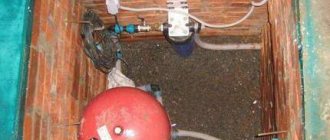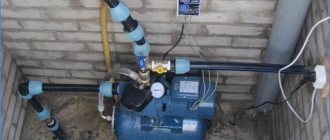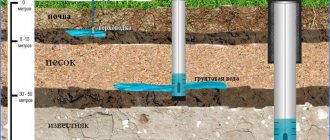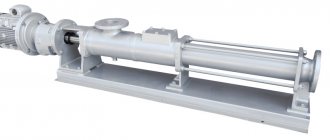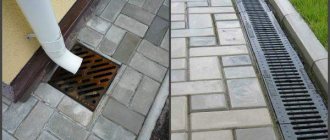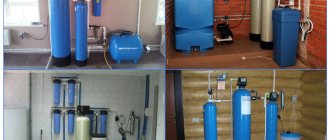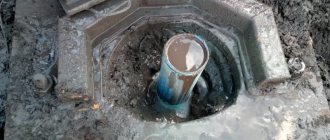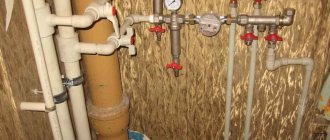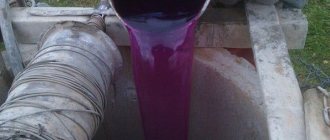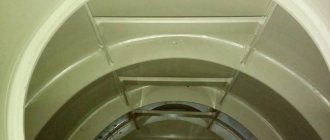Well plugging
What is water well plugging? Source plugging is a series of measures that are aimed at protecting a well from contaminants of various origins. Tamponing is carried out at artesian springs. During the procedure, the aquifer is separated from the soil.
Features of the concept of plugging. The soil in the well contains various microbes with dirt, which can contaminate clean water. To prevent contamination of the liquid, a special air layer is created using plastic or cement.
These materials, laid in a layer, separate the soil and water in the well. Thus, grouting ensures the tightness of the isolation of the layer that provides water from the external environment in the well. This type of work is performed by construction companies.
Process Features
Well plugging during abandonment is a set of works to fill cracks in the soil using cement mortar or other binder. For these purposes, it is advisable to use a material that can harden quickly. Otherwise, the required result will not be achieved.
Grouting and abandonment of artesian wells does not allow the following impurities to seep into the well (water intake structure):
- Petroleum components.
- Solid particles from the soil.
- Ground liquid.
Cementation allows you to seal the space that forms near the casing and the walls of the penetration. This process requires the injection of some kind of binder around the casing or into the bore.
Grouting works are divided into the following types:
- Liquidation. This procedure is performed if the old well is dangerous when used or threatens to collapse. In this case, it is removed by cementing. Liquidation plugging can significantly reduce the likelihood of groundwater contamination with harmful substances.
- Protective. This method avoids the penetration of groundwater into the spring. Undershoe cementing prevents leakage of water, which is dangerous to human health.
Before plugging, it is mandatory to examine the well and take water samples inside the structure. If there are indications for carrying out work, the preparation of documents begins (a report is drawn up, a project is developed).
After the documentation is approved, the walls of the structure begin to be plugged. This can only be done by experts from special services who have sufficient experience and appropriate equipment.
Categories of abandoned wells
The instruction from RD 08-347-00 establishes the following categories of wells that are abandoned after closure:
- Exhausted. A well that has reached the end of its service life must be abandoned; this category includes sources after long-term operation with a low flow rate, in which preventive pumping work does not give a positive result.
- Geologically ineffective. The group includes drilled mines that have not reached the aquifer, ineffective in further exploitation due to low flow rate (with a dusty geological sand structure) or sources that are silted for various reasons. Sometimes wells become unusable due to contamination of the aquifer with waste from nearby enterprises, landfills, storage facilities for harmful chemicals or other industrial facilities.
- Failure due to technical reasons. This group includes wells where there has been corrosive or physical wear, damage to the casing as a result of natural disasters (earthquakes, landslides). One of the reasons for the closure is the fall of a submersible electric pump into the canal, as a result of which further operation of the source is ineffective or hazardous to health.
- Harmful to the environment, installed in violation of technology. This group includes sources with low-quality casings, expired conservation periods, located in restricted zones (sanitary protection, water protection) without approval from environmental authorities. Borehole sources operating in zones where there has been a change in the environmental situation, which has caused a discrepancy between environmental and sanitary requirements for the new status of the zone.
Benefits of performing the procedure
Cementing hydraulic structures has many advantages. This allows not only to improve water quality, but also to extend the service life of the structure. With tamponage you can achieve:
- Additional waterproofing of the structure.
- Reducing the likely risk of deformation during installation of additional fasteners on the column.
- Increased protection against depressurization of structural joints.
- Complete sealing of water resources that are extracted from the well.
The liquidation type of work also has its advantages. With the help of such grouting, it is possible to protect groundwater from pollution and secure emergency wells. Wells that have become unusable are dangerous because they can lead to injury to a person or even an accident.
The procedure is quite expensive, but the benefits completely justify it. Especially when it comes to a well that is used by several houses.
Protection against high water
Liquidation plugging is not used for Abyssinian wells and sand wells. This is due to the fact that these structures are not deep enough to risk possible contamination of artesian waters.
Such structures are plugged directly during construction. The main goal of the entire process is to protect the aquifer from the ingress of perched water. To do this, you need to plug the space near the pipe.
Several methods are used:
- Using concrete mortar. There are simpler methods of insulation, so concrete is used quite rarely. Crushed stone is poured around the pipe, and then the space is filled with cement-sand mortar.
- Application of bedding. Sometimes you can use the simplest waterproofing. This method implies that a film is spread around the well and then covered with earth.
- Arrangement of the clay layer. First, a layer of crushed stone is poured into the space around the pipe, and the upper few meters are filled with clay. This is a fairly effective and economical method of sealing, as a dense waterproof layer is formed.
These methods allow you to quickly plug Abyssinian and sandy wells. The work does not require the involvement of specialists.
When is it necessary to abandon wells?
Liquidation of a water well may be caused by the following reasons:
1. During drilling, an aquifer was not discovered (absence or too deep), an insurmountable obstacle or the geological structure of the soil makes the construction of a well unprofitable (fine pulverized sand).
2. Wells that have expired. A well source on sand can operate from 5 to 15 years, after which its flow rate decreases and operation becomes unprofitable.
The main factor influencing the service life of the well is the composition of the sand - with a fine-grained structure, sanding will occur quite quickly, if the fractions are large, the well will last much longer (the service life on pulverized sand is several days).
3. Impossibility of further exploitation due to severe pollution (silting) of the aquifer. This problem only occurs in sand wells under the following circumstances:
- Incorrect installation of the well during drilling. As a result, the lower pipe with the filter in the casing will not be located in the aquifer, but will go too deep into the sandy-silty bottom. As a result, water will enter the source only through the upper part of the filter (the lower part will be in the rock), and over time, sandy sediment will block the inlet holes.
- Mistakes when selecting a well filter. A filter casing pipe with holes that are too large will lead to a large amount of sand fractions entering the channel and causing it to silt.
- Low water consumption. Low water flow will lead to the fact that small sand or clay particles that are not pumped from the source to the surface will gradually settle to the bottom, reducing the well flow rate. If pumping is not carried out in a timely manner, the thickness of the bottom sediments will increase over time, they will become too dense in the lower part and further exploitation of the source will become impossible.
- Use of surface electric pumps. If the source has a depth significantly exceeding the maximum lifting height of self-priming surface pumps of 9 meters, then as a result of water intake from its surface, and not in the near-bottom area, siltation of the bottom will occur over time, leading to a decrease in the static level and well flow rate.
- Application of a vibration electric pump. As a result of vibrations, bottom sediments are gradually compacted and the well source quickly silts up. If the vibrating electric pump has an upper water intake or is located too high, the process is further accelerated.
4. Technical problems. In individual wells, damage to plastic casing pipes may occur (cracks during installation and during operation, surface destruction when using defective materials). Common reasons for well abandonment are the fall of the electric pump or its parts into the well channel as a result of improper installation. If it cannot be removed to the surface, it will block the filter inlets or contaminate the water through corrosion of internal parts or oil that may leak into the water source.
Rice. 2 Liquidation plugging of a well - diagram
Necessity of application
Cementation is a specific technological process that is necessary to cover and separate the aquifer with a special pad. The space between the earthen shaft and the water shaft is cemented. Concrete, clay and molten plastic can be used for this.
The purpose of the technological process is to prevent the possible entry of chemical and biological contaminants into the consumed and underlying water. The procedure is performed in the following cases:
- It is necessary to increase the waterproofing of the structure, as the water quality has decreased.
- The water point will no longer be used.
- Defects have been discovered in the well design or geological problems have been identified.
- Productivity has decreased, but there is no way to restore the structure.
- It is necessary to eliminate the risk of water contamination if the drilling or use of the well was carried out improperly.
- It is necessary to prevent mixing of different water horizons.
- The structure was severely deformed or collapsed.
In addition to all of the above, the cementing procedure is performed when searching for new aquifers. If drilling is unsuccessful, it is necessary to plug the well.
Description of types of plugging
If we consider the geological reasons in more detail, we can say that in this case the water intake may simply cease to fulfill its role, which quite often becomes a consequence of geological processes. Technical reasons are the case when the water intake has not been maintained in working condition for a long time.
An alternative option may be a violation of technical standards during drilling. The work may have been carried out using inappropriate materials, repairs were not carried out for a long time, and maintenance was not carried out. Well plugging is also carried out in cases where the water intake was built for temporary use.
Types of binding solutions
Tamponation is a rather labor-intensive process that requires proper preparation. Therefore, you first need to perform preliminary calculations . They take into account the following:
- The distance between the ground and the hydraulic structure.
- The depth of the aquifer.
- Amount and composition of soil.
- Possible violations during the construction and operation of the structure.
- Presence of impurities in water.
Binders are selected based on the composition of the soil and its type. This is the most important factor. The following solutions are used for work:
- Cement mortar with the addition of fibrous components, asbestos or paper. This substance is used for wells that are located on floating or porous soils.
- A mixture of Portland cement and sand. This solution is used to cement structures built in clay and loam.
- Liquid plastic and foam solutions. They are used for structures located in hard soils. With their help, you can achieve maximum waterproofing of structures.
I always make solutions for grouting work liquid to increase convenience and reduce the load on pumping equipment. Pumping is carried out through the inlet pipe.
Preparatory work
Before performing tamponage, a preparatory stage is mandatory. If there are pumps or other equipment inside the water well, it must be turned off and raised to the surface. It is advisable that the execution of all work be supervised directly by the owner of the well, since it is he who will be responsible for all possible negative consequences.
Also, before using cement-sand mortar, you must obtain approval from the sanitary and epidemiological station. Otherwise, a large fine may follow.
After completion of the plugging, the well owner will have to do water tests to obtain a conclusion about its safety. It will also be necessary to take all supporting documents to the sanitary and epidemiological station and utility services.

